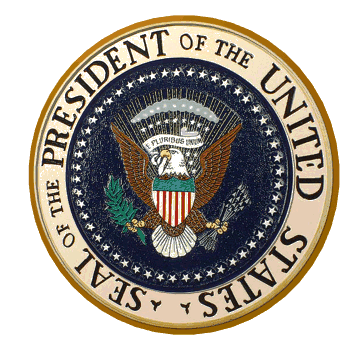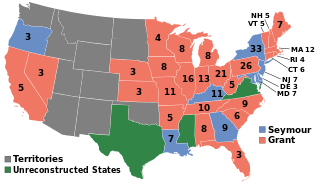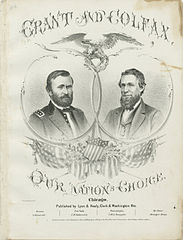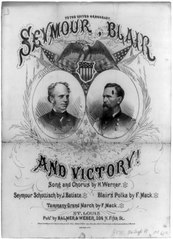 TheUSAPresidents.com
TheUSAPresidents.com 
 TheUSAPresidents.com
TheUSAPresidents.com 
 We have pages on every election!
We have pages on every election!

AndyHogan14, Public domain, via Wikimedia Commons
The 1868 election took place on Tuesday. November 3, 1868.

An image showing Ulysses Grant for president and Schuyler Colfax for vice president. Though the National Union slogan appears here, most Republicans dropped it by this election.

An image showing Horatio Seymour for president and Francis Preston Bliar Jr. for vice president.
Remember how in 1864, how President Lincoln was able to be re-elected and the Civil War was still happening? Well, just over a month after Lincoln's second inauguration, two big things happened. First, The Confederates basically completely surrendered. The war technically didn't end until May 1865, but it was basically over by mid-April when forces surrendered in the South, the biggest being the surrender of Robert E. Lee's forces to Ulysses Grant's forces (wait, he sounds familiar!) The second thing that happened, was more tragic, however. Lincoln was assassinated in Ford's theatre and died the next morning on April 15, 1865. So Andrew Johnson, his vice president, took over. By 1868, Johnson was not so popular. He had been the first president to be impeached, and was acquitted from being removed from office by one vote. Yeah. One vote. (And y'all thought Donald Trump was bad?!) Anyways, most of the heat came from the Radical Republicans in Congress who believed in severely punishing the South and giving rights to African-Americans. Johnson, as a Pro-War Democrat, did not agree. His whole presidency was basically just Congress overwhelmingly supporting a bill, Johnson would veto it, and Congress would immediately overrule it (Like, within a day.) Schuyler Colfax, Grant's running mate, was one of those Radical Republicans, by the way. Horatio Seymour was interesting (Just look at his facial hair!) But seriously, this guy did not want to be president at all. He passionately said no, but the Democrats couldn't find anyone, and Seymour was popular. Now, you may think that with all of this, this election is a super important one in America's history. However, Andrew Johnson's actions would still promptly delay Civil Rights for around a century.
As seen on the electoral map, some states still hadn't officially rejoined the Union. Therefore, the electoral college only went back up to 294 electors; 148 needed to win. 5,722,440 people voted in this election.
Attributions are listed in order of when elements appear on the page.
McClean, Alexander.; Balmer & Weber., Public domain, via Wikimedia Commons
Cornell University Library, No restrictions, via Wikimedia Commons
TheUSAPresidents.com
About Us Legal Political policy Reliability
Information on this site should not be plagiarized. This site is intended for hobby purposes, not commercial. Visit here for more information.